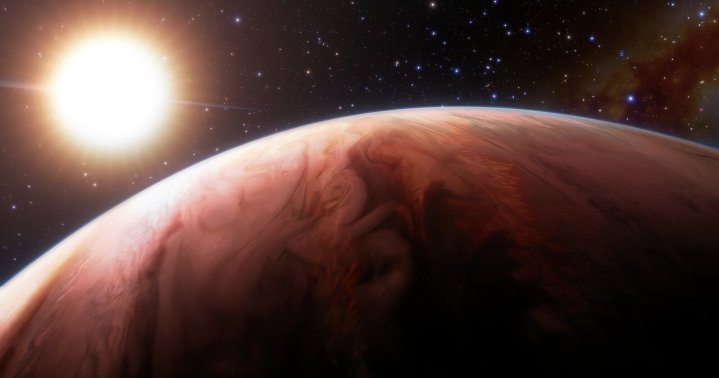Astronomers have studied a strange, puffy, scorching-hot planet located 600 light-years away, and have seen elements that would normally form rocks, but are so hot that they have vaporized into the atmosphere.
The planet, named WASP-76b, is around the mass of Jupiter, but orbits its star 12 times closer than Mercury is to the sun. Being so close, its atmosphere its heated to a scorching 2,000- degrees Celsius, which makes it puff up to a large size that’s six times the volume of Jupiter. These high temperatures also give astronomers the opportunity to observe elements that would normally be hard to identify in the atmosphere of a gas giant.

The researchers found a number of elements that would usually form rocks, like magnesium, calcium, and nickel. But because of the extreme temperatures, these elements are actually in gas form on WASP-76b. In total, the researchers identified 11 elements, including those which are thought to be present in gas giants like Jupiter and Saturn, but whose concentrations haven’t been measured.
That means that by studying this exceptionally hot planet, we can learn something new about other gas giants. “Truly rare are the times when an exoplanet hundreds of light-years away can teach us something that would otherwise likely be impossible to know about our own solar system,” said lead researcher Stefan Pelletier of the Université de Montréal in a statement. “That is the case with this study.”
One theory suggested by the data is that this planet may at some point in its history have swallowed a smaller planet, which was more like Mercury. Mercury is composed of metallic compounds and silicate, unlike the primarily helium and hydrogen that makes up gas giants.
And one more intriguing finding here was the first detection in an exoplanet of vanadium oxide, a compound that can have a significant impact on exoplanet atmospheres. “This molecule is of high interest to astronomers because it can have a great impact on the atmospheric structure of hot giant planets,” said Pelletier. “This molecule plays a similar role to ozone being extremely efficient at heating Earth’s upper atmosphere.
The research is published in the journal Nature.
Editors’ Recommendations
Services Marketplace – Listings, Bookings & Reviews